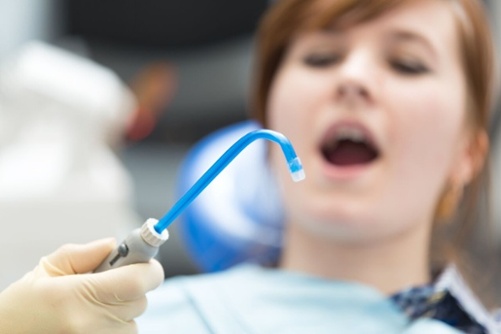
In order to make your dental procedure as safe and comfortable as possible, clinical practitioners make sure to keep saliva, fluid and other gruesome goodies from pooling in your mouth. Evacuating the oral cavity of excessive moisture is a common part of dental treatment, but it’s essential that it be done properly so as not to compromise the patient’s health.
Many clinicians use a device called a saliva ejector—a straw-like, perforated suction tube that sucks out moisture from your mouth. While saliva ejectors have been around for decades, there are risks involved with their use that most people aren’t aware of. When you tighten your lips around the tip of the ejector and the pressure in your mouth becomes less than that of the saliva ejector, backflow can enter your mouth. (This is similar to how liquid flows back into your cup after sucking through a straw.) The problem is that this backflow may be hazardous.
According to the Centers for Disease Control and Prevention, blood, saliva and other potentially infectious material (OPIM) from a previous patient sometimes remain in the vacuum line of the saliva ejector. That means they can be aspirated into your mouth if the saliva ejector is used improperly.
Studies have shown that cross-contamination between patients can result from the backflow of bacteria dislodged from saliva ejectors. A PubMed study revealed that the majority of the bacteria isolated from backflow samples were staphylococci, micrococci, and non-fermenting Gram-negative rods. Infectious agents such as Pseudomonas aeruginosa and Staphylococcus aureus were also isolated from backflow fluids.
Here are six things you can do to avoid backflow episodes:
- Never create a vacuum by sealing your lips around the saliva ejector
- Never suck on the saliva ejector
- Ask your dental professional if they use a backflow prevention mechanism
- Ask your dental professional how often they flush the vacuum lines. (Ideally, they do it after every patient.)
- Ask your dental professional about single-use evacuation options
- Tell your dental professional that you value their attention to equipment cleanliness
Although the risk of cross-contamination due to backflow is considered to be low, infection control should always be a top priority. Disposable and single-use evacuation products are available to lessen the risk of patient-to-patient contamination.
Zyris is committed to sound infection control practices and urge you to join us by sharing this information to help protect the health of your family and friends.
 (800) 560-6066
(800) 560-6066